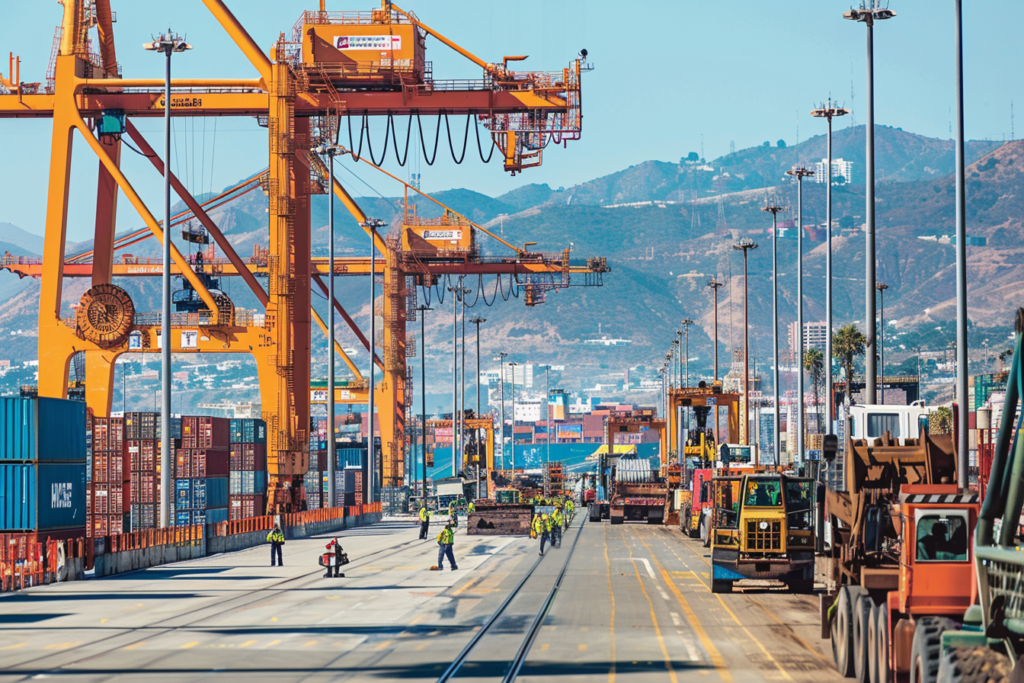Nearshoring Influences Ensenada’s Port. Hutchison Ports EIT in Ensenada, Baja California, is experiencing significant operational shifts due to nearshoring, as Asian manufacturing firms move closer to North American consumer markets. This trend has already impacted the terminal positively, with over 50% of the volume coming from maquiladora industries, according to Javier Rodríguez, the general manager at EIT.
The Multi-Use Terminal (TUM) at Hutchison Ports primarily serves businesses from northwestern Mexican cities like Tijuana, Mexicali, Tecate, and others extending to Ciudad Juárez, many of which directly connect to industrial markets in Southern California and Texas. In response to the increased demand from nearshoring and the general industry, the port is undergoing an expansion to enhance capacity and efficiency as part of its master plan.
This expansion, budgeted at 2.3 billion pesos, includes a 300-meter dock extension and the installation of advanced, sustainable technologies like a super post-Panamax crane and electric yard cranes. Set to increase static capacity to over 7,500 TEUs, these upgrades not only boost operational efficiency but also align with Hutchison Ports’ NET Zero strategy, aiming for significant reductions in greenhouse gas emissions by 2050.
Progress on Tijuana’s Infrastructure. The Tijuana elevated viaduct project has achieved a 16.30% completion, announced Brigadier Engineer Constructor Raúl Manzano Vélez. He highlighted the placement of the first column, signaling noticeable progress ahead. Although the completion date remains unspecified, adjustments are being made to accommodate the terrain and residential areas without compromising existing homes.
During a phone call in President Andrés Manuel López Obrador’s morning conference, Manzano Vélez reported on related infrastructure efforts, including a 160-meter advancement in the tunnel between El Soler and Cañón del Matadero, and a 67% completion of the Otay II checkpoint and its access viaduct. The latter project, expected to be equipped by the end of the term, has 1,700 workers in two shifts working extended hours to meet deadlines.
Additionally, the rehabilitation and modernization of the San Antonio de Los Buenos wastewater treatment plant are underway, with 80% of the area cleared for new construction. This plant, set to treat about 33% of Tijuana’s wastewater, is on schedule to complete by September, promising to meet national standards for water quality.
Tijuana’s Tinted Windows Reform Stalled. Six months have passed since the Tijuana City Council approved a change to allow medium and low-intensity tinted windows for citizens, but the reform hasn’t been officially published yet, delaying its activation. Ex-councilwoman Georgina Arana Cruz, who championed the reform, pointed out the lack of publication in the State Official Gazette as the reason for the hold-up. Despite repeated inquiries to the Secretary-General of the Government and the mayor about the delay, Cruz has received no response. The reform aims to permit lower levels of tint for public use, reserving the darkest tints for police vehicles, to reduce extortion incidents which have even affected individuals with medical conditions requiring protection from sunlight. The publication has been further delayed by requests to clarify the definitions of tint levels, which remain unresolved.
Budget Cuts Impact Rosarito Projects. Rosarito will face a significant financial setback as it anticipates a reduction exceeding 30 million pesos in federal and state funding this year. This shortfall has forced the municipal government to cancel three planned infrastructure projects to balance the budget. The Treasury reported that a recent meeting with state finance officials confirmed the reduced allocation, which is 36 million pesos less than initially budgeted. Efforts to mitigate these cuts had already led to the cancellation of two other projects involving the refurbishment of local government and social services offices.
Additionally, the planned renovation of Bonfil Boulevard, which included sidewalk, lighting, and equipment upgrades worth 30 million pesos, has now been scrapped due to funding constraints and costly proposed changes by the local water commission. The municipality also faces new financial burdens, such as a 20 million pesos annual payroll tax and the loss of a 7 million pesos compensatory fund, prompting further budget adjustments, particularly in social and cultural expenditures.
Rosarito Beach Corridor Nears Completion Amid Permit Uncertainty. In Rosarito, a nearly completed corridor along the beachfront has sparked concerns, as municipal authorities have not confirmed whether the Quinta Pacífico development has the necessary permits for its construction. The project includes a nearly 3-meter-high retaining wall that was built over a year ago, disrupting pedestrian access, especially during high tides. This development led to numerous complaints, and it was revealed that the municipality was unaware of the construction permits, finding only a legal injunction filed by the developer, with no further legal progress reported.
The corridor, dubbed a “tourist corridor,” now features stairs and a cemented pathway delineating the beach area designated to the development. According to a security guard, the pathway restricts public access to the sand. Funded privately, the corridor’s execution and authorization remain ambiguous, raising questions about public use and oversight.
Baja Boosts Sport Fishing. During the “Day at the Docks” event in San Diego, an aquatic sports gathering, the Baja California Secretary of Fisheries and Aquaculture (Sepesca BC) promoted sport fishing opportunities in the region. Alma Rosa García Juárez, head of Sepesca BC, was invited by Ken Franke, president of the Sportfishing Association of California, to highlight Baja California as a prime location for both relaxation and fishing adventures.
At the event, García Juárez introduced the official sport fishing website for Baja California, www.bajasport.fishing, which features a comprehensive calendar, federal procedures, top fishing spots, and service providers in the region. She also announced that this year, 13 fishing tournaments are scheduled across various locations from El Carrizo Dam in Tecate to Cedros Island and Ensenada.
Highlights include the “Dos Mares” tournaments in San Felipe and San Quintín, offering over one million pesos in prizes, and the “Reinas del Mar,” the second women-only tournament in the state, to be held in Ensenada’s bay. Additionally, the successful “Baja Bluefin Tuna Tournament” is set for its second edition in Ensenada this May.
Baja is a Leader in Job Creation. Baja California ranked third nationally in job creation last March, adding 25,659 new jobs across various economic sectors, Governor Marina del Pilar Ávila Olmeda announced. Citing data from the Mexican Social Security Institute (IMSS) for the first quarter, she emphasized that the state contributed 9.7% of the 264,959 jobs created nationwide during this period.
Highlighting efforts to improve living standards, nearly half of these new jobs were permanent positions, making up 47% of the total. Ávila Olmeda pointed out that the agricultural sector, particularly in Ensenada, was the largest job generator, followed by significant contributions from Tijuana and Mexicali.
Kurt Ignacio Honold Morales, head of the Secretary of Economy and Innovation (SEI), noted that agriculture continued to lead employment growth, followed by manufacturing and social services. He praised the impact of large enterprises in generating employment, reflecting a robust effort to bolster Baja California’s workforce and economic health.

